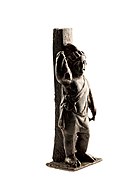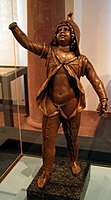Attis
Attis (Ancient Greek Ἄττις, from Phrygian attis, "beautiful boy" and/or attagus, "goat") is the son of the river nymph Nana in Greek and Phrygian mythology, whom she conceived from the seed of an almond tree.
Due to the Phrygian origin of the tales about Attis and their adoption into Greek as well as Lydian narrative material, there are several versions of his story - and a prehistory:
The almond tree originated from the blood that fell to earth with the emasculation of the bisexual being Agdistis, or from his male sexual organ, which he had torn out himself when it was tied to a tree by Dionysus with a rope made of hair. A fruit of the rapidly growing tree fell into Nana's lap, which she concealed in it, and she was imprisoned to die of hunger by her father, the river-god Sangarios, as punishment for this "unseemly behaviour". However, the Great Mother Kybele - as Agdistis was now also called after the emasculation - provided her with fruits and food of the gods until she gave birth to Attis. The latter, however, was abandoned by Sangarios after his birth, raised by a he-goat with goat's milk, and grew up into a beautiful youth.
Agdistis/Kybele fell in love with him with all her passion. When Attis was to marry the daughter of Midas, king of Pessinus, Agdistis/Kybele appeared at the wedding and drove Attis mad, so that he emasculated himself. Violets were created from the blood that dripped to the ground in the process. Attis himself, unlike Agdistis, did not survive his emasculation or else turned into the evergreen pine tree under which he had committed this act with the cry "Thee, Agdistis!".
When Kybele, filled with grief and remorse, beat her drum and went through Phrygia, a famine followed, whereupon an oracle was asked for advice by the Phrygians. These were now obliged to bury Attis and adopt Kybele as their deity, only eunuchs being admitted as priests of Kybele, in order to preserve the memory of Attis. Kybele is then said to have resurrected Attis from death and to have been worshipped together with him throughout Phrygia.
According to other versions, Zeus, in response to Agdistis/Kybele's pleas to bring the youth back to life, could only ensure that his body did not decompose, his hair continued to grow and his little finger remained mobile. For the meaning of the myth see Kybele.
In the Roman cult of the dead, Attis was depicted on tombstones to symbolize mourning for the deceased.
Catullus gives his version of the myth in his poem 63 ("Super alta vectus Attis celeri rate maria").
Photo Gallery
· 
Bronze figure of Attis, found in Tongeren (Belgium), Gallo-Roman Museum (Tongeren)
· 
Attis with flowing head hair as sun youth.
· 
Attis dancing, with asian knotted leg robe.
See also
- Cult of Kybele and Attis
Search within the encyclopedia